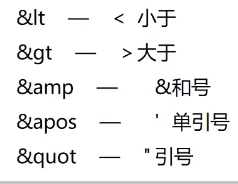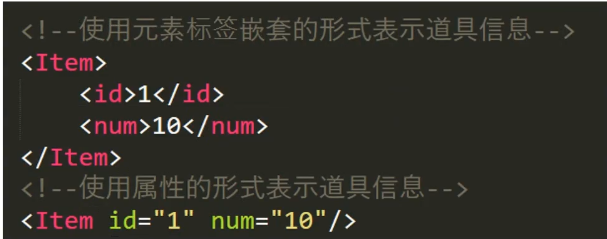【Unity开发】数据存储——XML
一、相关介绍
1、XML介绍
XML,全称可拓展标记语言(EXtensible Markup Language),是被设计用于传输和存储数据的一种文本特殊格式。
2、优缺点
优点:格式统一,符合标准,容易与其他系统进行远程交互,数据共享比较方便。
缺点:XML文件庞大,文件格式复杂,传输占带宽;服务器端与客户端解析XML花费较多的资源和时间。
3、基本规则
①每个元素都必须有关闭标签
②元素命名规则基本遵照C#中变量名命名规则
③XML标签对大小写敏感
④XML文档必须有根元素
⑤特殊的符号应该用实体引用

4、XML属性
(1)属性语法

(2)属性和元素节点的区别(只有写法上的区别)

5、如何检查语法错误
①元素标签必须配对
②属性必须有引号
③注意命名
④将内容直接复制到该网站进行验证:https://www.runoob.com/xml/xml-validator.html
6、XML存放位置
①只读不写,存放在Resources或者StreamingAssets文件夹下
②动态存储,放在Application.persistentDataPath路径下
二、具体实现
1、常用功能实现
using System.Collections;
using System.Collections.Generic;
using System.IO;
using System.Xml;
using UnityEngine;public class LoadXml : MonoBehaviour
{// Start is called before the first frame updatevoid Start(){#region 读取xml文件信息//方法一、读取Resources文件夹下的xml文件加载处理TextAsset textAsset = Resources.Load<TextAsset>("TestXml");print(textAsset.text);XmlDocument xml = new XmlDocument();xml.LoadXml(textAsset.text);//方法二、读取StreamingAssets文件夹下的xml文件加载处理//xml.Load(Application.streamingAssetsPath + "/Testxml.xml");#endregion#region 读取元素和属性信息//1、获取xml中的根节点XmlNode root = xml.SelectSingleNode("Root");//2、通过根节点获取下面的字节点XmlNode nodeName = root.SelectSingleNode("name");//3、获取节点包裹的元素信息print(nodeName.InnerText);//4、获取节点属性信息XmlNode nodeItem = root.SelectSingleNode("Item");//方式一print(nodeItem.Attributes["id"].Value);print(nodeItem.Attributes["num"].Value);//方式二print(nodeItem.Attributes.GetNamedItem("id").Value);print(nodeItem.Attributes.GetNamedItem("num").Value);//5、获取一个节点下的同名节点的方法XmlNodeList friendList = root.SelectNodes("Friend");//遍历打印信息//方法一、使用迭代器遍历foreach (XmlNode item in friendList){print(item.SelectSingleNode("name").InnerText);print(item.SelectSingleNode("age").InnerText);}//方法二、使用for循环遍历for (int i = 0; i < friendList.Count; i++){print(friendList[i].SelectSingleNode("name").InnerText);print(friendList[i].SelectSingleNode("age").InnerText);}#endregion#region 存储xml文件信息//1、存储路径//Resources 可读 不可写 打包后找不到 x//Application.streamingAssetsPath 可读 PC端可写 找得到 x//Application.dataPath 打包后找不到 x//Application.persistentDataPath 可读可写找得到 ✔string path = Application.persistentDataPath + "/PlayerInfo2.xml";print(path);//2、存储xml文件//(1)创建文本对象XmlDocument xml1 = new XmlDocument();//(2)添加固定版本信息XmlDeclaration xmlDec = xml1.CreateXmlDeclaration("1.0", "UTF-8", "");xml1.AppendChild(xmlDec);//(3)添加根节点XmlElement root1 = xml1.CreateElement("Root");xml1.AppendChild(root1);//(4)为根节点添加子节点XmlElement name = xml1.CreateElement("name");name.InnerText = "某某某";root1.AppendChild(name);XmlElement listInt = xml1.CreateElement("int");for (int i = 0; i < 3; i++){XmlElement childNode = xml1.CreateElement("int");childNode.InnerText = i.ToString();listInt.AppendChild(childNode);}root1.AppendChild(listInt);//(5)添加属性XmlElement itemList = xml1.CreateElement("itemList");for (int i = 0; i < 3; i++){XmlElement childNode = xml1.CreateElement("Item");//添加属性childNode.SetAttribute("id", i.ToString());childNode.SetAttribute("num", (i * 10).ToString());itemList.AppendChild(childNode);}root1.AppendChild(itemList);//(6)保存xml1.Save(path);print("成功保存到文件夹:" + path);#endregion#region 修改xml文件信息//1、先判断是否存在文件if (File.Exists(path)){//2、加载后 直接添加节点 移除节点即可XmlDocument xml2 = new XmlDocument();xml2.Load(path);//移除XmlNode node = xml2.SelectSingleNode("Root").SelectSingleNode("name");node = xml2.SelectSingleNode("Root/name");print(node.InnerText);//得到自己的父节点XmlNode root2 = xml2.SelectSingleNode("Root");root2.RemoveChild(node);//添加XmlNode speed = xml2.CreateElement("moveSpeed");speed.InnerText = "20";root.AppendChild(speed);//修改后 记得保存更新xml文件xml2.Save(path);}#endregion}
}
2、字典自定义序列化与反序列化实现
using System.Collections;
using System.Collections.Generic;
using System.Xml;
using System.Xml.Schema;
using System.Xml.Serialization;
using UnityEngine;public class SerizlizerDictionary<TKey, TValue> : Dictionary<TKey, TValue>, IXmlSerializable
{public XmlSchema GetSchema(){return null;}//自定义字典的 反序列化 规则public void ReadXml(XmlReader reader){XmlSerializer keySer = new XmlSerializer(typeof(TKey));XmlSerializer valueSer = new XmlSerializer(typeof(TValue));//要跳过根节点reader.Read();//判断 当前不是元素节点 结束 就进行 反序列化while (reader.NodeType != XmlNodeType.EndElement){//反序列化键TKey key = (TKey)keySer.Deserialize(reader);//反序列化值TValue value = (TValue)valueSer.Deserialize(reader);//存储到字典中this.Add(key, value);}reader.Read();}//自定义 字典的 序列化 规则public void WriteXml(XmlWriter writer){XmlSerializer keySer = new XmlSerializer(typeof(TKey));XmlSerializer valueSer = new XmlSerializer(typeof(TValue));foreach (KeyValuePair<TKey, TValue> kv in this){//键值对 的序列化keySer.Serialize(writer, kv.Key);valueSer.Serialize(writer, kv.Value);}}
}
3、XML存储与读取功能封装
using System;
using System.Collections;
using System.Collections.Generic;
using System.IO;
using System.Xml.Serialization;
using UnityEngine;public class XmlDataMgr
{private static XmlDataMgr instance = new XmlDataMgr();public static XmlDataMgr Instance => instance;private XmlDataMgr() { }/// <summary>/// 保存数据到xml文件中/// </summary>/// <param name="data">数据对象</param>/// <param name="fileName">文件名</param>public void SaveData(object data, string fileName){//1.得到存储路径string path = Application.persistentDataPath + "/" + fileName + ".xml";//2.存储文件using(StreamWriter writer = new StreamWriter(path)){//3.序列化XmlSerializer s = new XmlSerializer(data.GetType());s.Serialize(writer, data);}}/// <summary>/// 从xml文件中读取内容 /// </summary>/// <param name="type">对象类型</param>/// <param name="fileName">文件名</param>/// <returns></returns>public object LoadData(Type type, string fileName){//1。首先要判断文件是否存在string path = Application.persistentDataPath + "/" + fileName + ".xml";if( !File.Exists(path) ){path = Application.streamingAssetsPath + "/" + fileName + ".xml";if (!File.Exists(path)){//如果根本不存在文件 两个路径都找过了//那么直接new 一个对象 返回给外部 无非 里面都是默认值return Activator.CreateInstance(type);}}//2.存在就读取using (StreamReader reader = new StreamReader(path)){//3.反序列化 取出数据XmlSerializer s = new XmlSerializer(type);return s.Deserialize(reader);}}}
